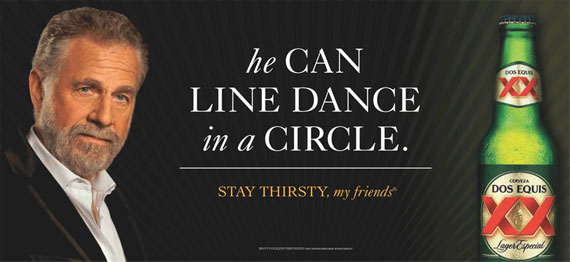Marketing, traditionally, has been about communicating the value of a product to potential customers for the purpose of selling that product at a profit.
Given this seemingly straightforward proposition, you might wonder why marketing messages are not more direct. As an example, why doesn’t Cuauhtémoc Moctezuma, the brewery that makes Dos Equis beer, simply produce ads that say things like “Our Beer Tastes Good”? Instead the company has built a huge, multi-year, multi-channel campaign around “the most interesting man in the world,” who we are told doesn’t always drink beer, but when he does he drinks Dos Equis.

Dos Equis’ “Most Interesting Man in the World” campaign.
Similarly, why does Old Spice promote its brand with ads featuring Isaiah Mustafa, Fabio, and Terry Crews (all relatively handsome and fit guys) in a series of quirky ads, rather than just saying that their products are effective?
Customers Don’t Listen
Perhaps, the main reason that marketing, which is a simple task at its core, requires analysis, strategies, testing, and much more is that most customers do not listen. In fact, how could they listen to everything? There is simply too much going on, too many messages, from too many different businesses trying to be heard.
Marketing and advertising in the modern, mobile, Internet age means that the intended audience is inundated with messages talking not just about products, but, as marketing expert Jay Baer frequently points out, with messages from friends and family. In that context, Baer explains, marketers are not just competing with other businesses, but with a potential customer’s friends and family for a share of time and attention.
In the case of “the most interesting man in the world,” the campaign breaks through the racket of messages and advertising because it is entertaining. Many men would love to be the most interesting man in the world, and they find the dialogue entertaining. Consider a few examples:
- “He can line dance in a circle.”
- “He gave his father ‘the talk.’”
- “He can speak Russian…in French.”
- “His signature won a Pulitzer.”
- “In museums, he is allowed to touch the art.”
- “When he goes to Spain, he chases the bulls.”
Usefulness Is the Way to Break Through
“Today’s consumers are staring at an invitation avalanche, with every company asking for likes, follows, clicks and attention. This is on top of all the legacy advertising that envelops us like a straitjacket. There are only two ways for companies to break through in an environment that is unprecedented in its competitiveness and cacophony,” Baer wrote in his book Youtility. “They can be ‘amazing’ or they can be useful.”
In this contest, being useful can be defined as providing a useful service, giving useful information, or impacting a potential customer’s needs, including things like entertainment or a feeling of belonging.
In a way, marketing in 2014 has become the task of being useful to customers to build a relationship with those customers so that you can communicate about the value of a product in spite of the overwhelming sea of promotions.
New Marketing in Practice
You’ll find this new marketing in use, in both obvious and subtle ways. Returning to the Dos Equis example, consider the beer finder on the Dos Equis site. The tool is nothing more than a dealer locator, if you will, but if you are a fan of Dos Equis, and you are in unfamiliar territory, this tool will lead you directly to the nearby bars and restaurants that serve Dos Equis.
As another example, a multi-channel retailer in the northwestern United States recently offered a series of beekeeping classes for free. The retailer brought in expert speakers including representatives from beekeeping supply manufacturers, local beekeepers, and an apiologist (a scientist who studies bees) to give presentations. The classes garnered about 1,000 registrants, who now think of the retailer as an expert in beekeeping. Given that the bees, hives, and equipment necessary to get started with beekeeping can cost $1,200, the retailer is making a sound marketing investment and a useful service for the customers.
Miller, a maker of welders and welding supplies, has an extensive library on its site of how-to videos that demonstrate welding techniques. The videos certainly show off Miller’s products, but really they are useful to customers too. These videos can help a do-it-yourselfer learn the basic principles of MIG welding, as an example, all while building a utility-based relationship with Miller. Can you imagine a novice welder, spending hours watching videos on the Miller site, learning new welding concepts and techniques, and then shopping for some other brand of welder?

Miller welding products’ site contains extensive video training.
Mr. Porter, the men’s fashion retailer, publishes The Journal, an online magazine. It is yet another example of useful marketing. You might look at it as just a blog, but this high-quality online publication provides useful (in the sense of entertaining and informative) content that some site visitors return for again and again simply for its insights on pop culture and style.
Consider this bit from the recent article, “Proper Address Required?”
A few weeks ago a couple was coming over for dinner. “What time will Harvey and Susan be here?” Nicholas asked. He knew these adults slightly, as he had gone to nursery school with their son, but they were hardly his close personal friends. So using their first names struck me as a little fresh — especially from an eight-year-old.
“Don’t you mean, ‘What time will Mr. and Mrs. Silver be here?'”
“No, Dad, they’re more of a Harvey and Susan than a Mr. and Mrs. Silver.” His reply implied some type of social judgment — one that I was curious to get to the bottom of. It appeared that Nicholas had developed his own app for deciding which adults merited the formal salutation of “Mr. and Mrs.” and which adults he deemed it OK to greet casually. Was the distinction based on familiarity, social rank or whether he frequently saw them stuffed into yoga trousers?
The whole what-to-call-adults conundrum is yet another example of how today’s children are forced to interpret and improvise in a way that my generation did not. When I was growing up, the rule was ironclad: every single adult was greeted as Mr. and Mrs. As a cub reporter I was taught: address anyone as Mr. until he asks you to call him by his first name. …
Does it read like something that you would expect to find on an ecommerce site? Probably not, rather this article is about providing great content to the site visitor, to build a relationship that will eventually give Mr. Porter the opportunity to communicate the value of the products it sells.




